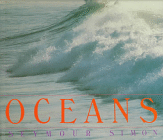Carol Hurst's Children's Literature Newsletter, Winter '99, page 2.
by Carol Hurst and Rebecca Otis.
|
This issue is sponsored by Teaching K-8 Magazine. Subscribe now for only $12.00 |
Featured Subject: Oceans

The ocean is vast and so are the numbers of books that be linked to a theme on the ocean making it too big for one newsletter. Let's restrict ourselves to a theme for K-3 for this quarter, leaving an upper grade theme on the ocean for some later date.
As with almost anything involving natural science, I reach first for a Seymour Simon book. His photographic essay Oceans (Morrow, 1990; ISBN: 0688094546. Library Binding.) is a mind-bending combination of exquisite photographs, clear diagrams and charts, statistics, and a text full of exuberance and wonder. Leave it out on the table where the kids can get at it and they'll soon be wanting to know more. So, follow that book with The Magic School Bus on the Ocean Floor by Joanna Cole and Bruce Degen (Scholastic Trade, 1992 ISBN 0590414305. Library Binding.). Ms Frizzle and her class will give them lots of information and open doors to further exploration.
Although tides and waves and the ocean floor are interesting, it's the life in and around the ocean that fascinates most of us. Again it's Simon to the rescue. His Sharks (HarperCollins, 1996 ISBN 0064461874. Paperback.) and Whales (HarperCollins, 1992 ISBN 0064460959. Paperback.) will have the kids intrigued and comparing discoveries in no time. Add Mary Cerulio's only slightly more difficult Octopus: Phantom of the Sea (Cobblehill, 1997 ISBN 0525651993. Hardcover.) and you've got the three sea creatures that most delight and amaze young learners. Even kids who can't read the text of any of those books can gain lots of information by carefully perusing those photographs.
They need structure in which to record their information so it's time to get graphic. Food chains are interesting in any eco-system and the food chains in the ocean are many. Have the kids start making large images of single sea animals on cardboard circles or pizza boards. Place their creatures on the bulletin board and have kids find out what each one eats. If the prey is already on the board, connect it by making an arrow from predator to prey. If it isn't there, draw it and then connect. Get them searching for different creatures to place on the predator/prey board. Soon there should be extensive webs. You may want to place various stages in the life of those same creatures leading to a discussion and display of life cycles and, because some creatures are prey at various stages of their lives and predators at other, things can get nicely complicated.
After they've looked at Norbert Wu's Fish Faces (Owlet, 1997 ISBN 0805053476. Paperback.) they may be ready for art. Crayon resists make nice ocean artwork. Get the kids to bear down hard with wax based crayons to make the images of various sea creatures and then paint over them with blue watercolor. Mobiles and fingerpaint also lend themselves to ocean creations.
Bring on the music stretching all the way from "Down by the Sea" to Debussy's "La Mer". Let kids move, write, read and create art while the music plays.
Back to the books for the stories about the ocean. Jan Andrews' Very Last First Time with illustrations by Ian Wallace (Atheneum, 1985 ISBN 0689503881. Hardcover.) involves an Inuit rite of passage as a little girl walks under the ice when the tide is out.
Diane Hofmeyr's Do the Whales Still Sing? (Dial, 1995 ISBN 0803717407. Out of Print.) shows a reformed whale hunter. He loved hunting them down in the great whaling ships until he heard them sing one day. You can find recordings of whale songs or visit http://whale.wheelock.edu/whalenet-stuff/sounds/ to hear their sounds and those of other ocean creatures. Kids who are intrigued can go on to The Whales Song by Dyan Sheldon and Gary Blythe (Dial, 1991 ISBN 0803709722. Hardcover.) in which a little girl hears from her grandmother of a time when she used to hear the whales sing.
Frances Ward Weller and Robert J. Blake's Riptide (Putnam, 1990 ISBN 0698113861. Paperback) deals with the dangers of the sea. It's a good dog story too as a pesky dog on the beach becomes a hero.
Sea otters are in real danger now from orcas, of all things, so take a look at Swim the Silver Sea, Joshie Otter by Nancy White Carlstrom and Ken Kuroi (Putnam, 1993 ISBN 0698114477. Paperback.) in which a young sea otter becomes separated from its mother and Orcas Around Me by Debra Page and Leslie W. Bowman (Whitman, 1997 ISBN 0807561371. Paperback.). In the latter book we get to know a bit about orcas and salmon, as well. Finish it off with Sea Otter Inlet (Fitzhenry & Whiteside ISBN 1550410806.), a nonfiction book in which a whole ecosystem is destroyed because of over hunting.
Related Areas of Carol Hurst's Children's Literature Site
- Seymour Simon, Featured Author. Information on his life, books, and related links.
- Oceans by Seymour Simon, book review.
Related Areas on the Internet
- Yahoo's listings for Oceanography
- Discovery Channel's Sea Otters Page
- Ocean Planet Homepage from a Smithsonian Exhibit
- Oil Spill Public Information Center
![]()
Go to Next Section of Newsletter, Book Reviews.
Return to Table of Contents of the Newsletter.
Advertisement:
Advertisement:
Advertisement:

